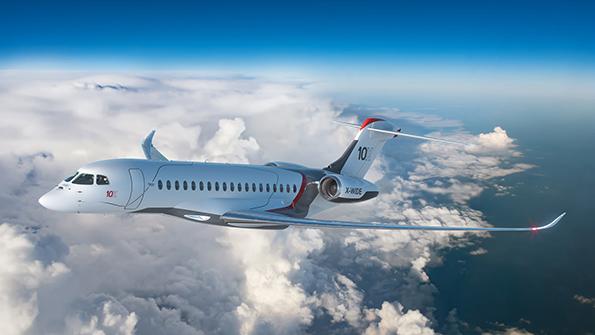
The ultra-long-range Falcon 10X, just announced by Dassault, will be the biggest and most expensive Falcon yet. The company wants to regain its position at the top of the market—or, to put it another way, it needs to correct a disastrous mistake made 28 years ago.
Until the Gulfstream V and Bombardier Global Express were launched in the 1990s, Dassault had always been equal to or greater than its high-end rivals. But the new jets redefined the top segment, selling for 25-30% more than the previous high end, with much bigger cabins and much greater range.
In mid-1992, Dassault also considered a jet in this class: a long-range derivative of the Falcon 900 and 2000. Designated the Falcon 9000, the new aircraft would have the trijet configuration of the 900 and the Honeywell CFE738 engines of the 2000. Dassault hoped to make a launch decision by the end of 1993 but shelved the program in October of that year. It viewed the emerging high end as an already saturated niche segment with further competition from business adaptations of commercial jetliners.
The results were disastrous for Dassault. Gulfstream and Bombardier sold a combined total of more than 1,800 GV and Global-series jets. This segment was quite profitable, too.
A third player would have diluted these high-end fortunes, but for that would-be third player, the result was a sharp market-share decline. Dassault held 36% of the market by value of deliveries in 1987, its all-time high. By the late 1990s, it had fallen to about 17%. As the chart indicates, its average share over the last 10 years was 14%. It was just 9.9% last year, an all-time low.
Worse, Bombardier and Gulfstream went on to prove that there was an even less price-elastic ultra-high end, with the G650 and Global 7500 raising the bar yet again. Dassault was stuck playing catch-up. While the Falcon 7X/8X belatedly got Dassault into GV/Global Express territory, it was a long way from the new ultra-high end. The 10X will be aimed exactly at this $75 million-price segment.
Aside from the need to revisit a mistake, the new jet results from two other factors, one internal to Dassault and the other concerning the competition.
First, the recent tragic death of Olivier Dassault, one of the primary family scions, raises questions about the future. For decades, Dassault has been run without the level of investor demand typically imposed on most aerospace companies. The family has remained a majority shareholder. It has been able to allocate resources to engineering and product development without concern that activist investors, or any other shareholders, will impose demands for returns.
But as the family’s shares pass on to younger generations or are sold off to non-family investors, this situation could change. Greater discipline could be imposed by new shareholders on new product launches. Now might be the last time the company is able to freely decide to make this kind of risky bet on an expensive new civil product.
Second, Dassault’s defense side is doing quite well, with a remarkable breakthrough in Rafale sales to Qatar, India and Egypt. The same week in which the 10X was launched, Egypt more than doubled its Rafale order, to 54 aircraft.
Bombardier, meanwhile, has become the world’s only pure-play, publicly traded business-jet prime. It has almost no defense revenue, in contrast to Gulfstream (with its General Dynamics parent) and Dassault. Dassault might think it smells blood in the high-end waters with a vulnerable incumbent.
Just because Dassault can launch the 10X doesn’t necessarily mean the investment will be successful. Gulfstream has built more than 450 G650s, and the G700 will arrive with great fanfare next year. Bombardier, while late to the game with the 7500, is now building the 89th jet and says it is sold out through 2023 with a production rate of 35-40 per year. It will be difficult for a third player to break in at this stage.
But given Dassault’s loyal customer base and the prestige the Falcon line still enjoys, the 10X will be at least modestly successful. Our forecast calls for the company to climb to 19% market share a few years after the 10X arrives (with an average of 14% over the next decade). And as Dassault’s market share has steadily eroded over the past 25 years, it likely would find the alternative to this investment much worse.
The views expressed are not necessarily those of Aviation Week.





